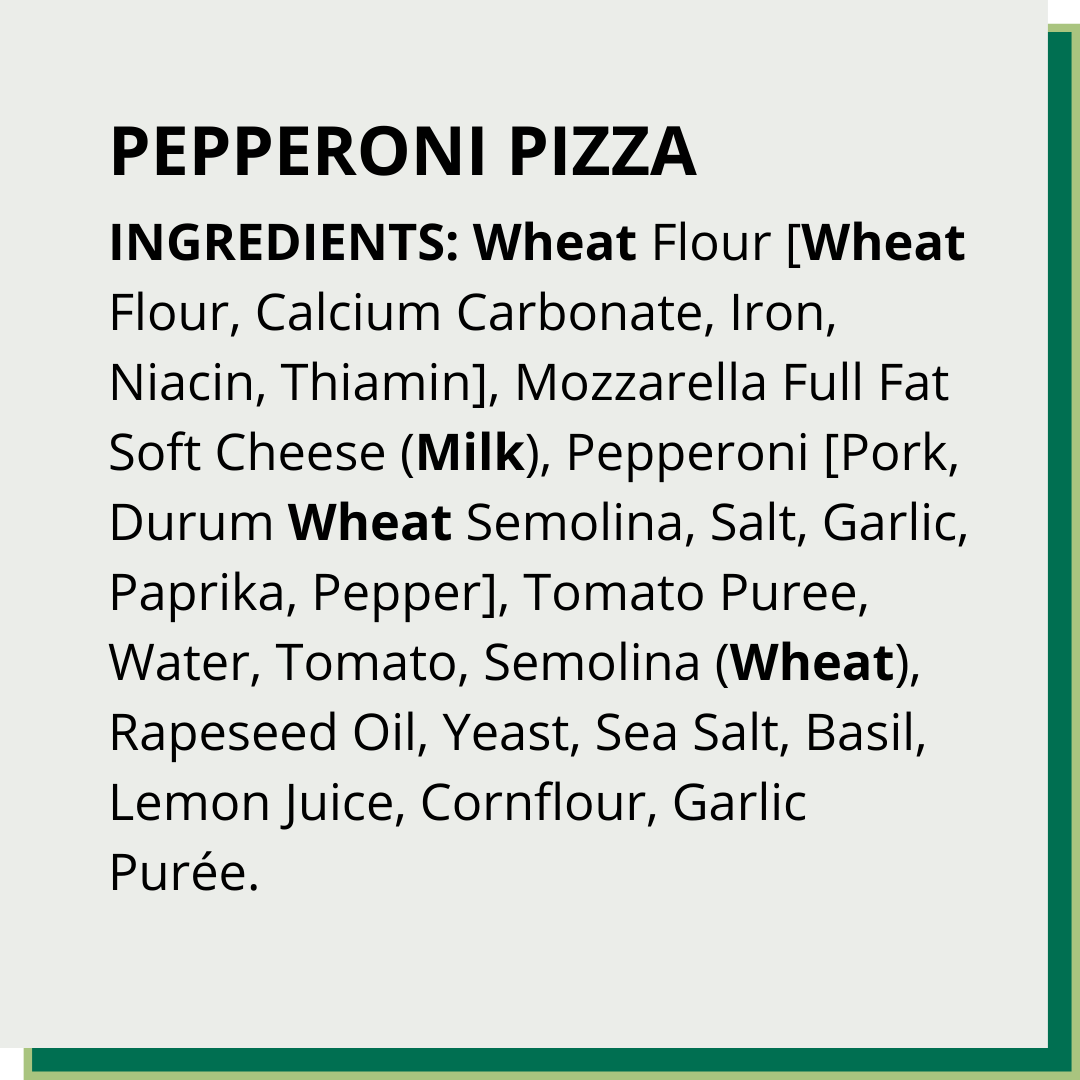Prepacked for direct sale (PPDS) allergen labelling changes for fast food and takeaway restaurants (PPDS)
Information for fast food and takeaway restaurants on the changes to allergen labelling for prepacked for direct sale (PPDS) food, also known as Natasha's Law.
From 1 October 2021 the requirements for labelling prepacked for direct sale (PPDS) food changed across the UK.
Also known as Natasha's Law, this applies to any food business that produces PPDS food, including kebab shops, burger restaurants, pizzerias, fried chicken shops, Chinese takeaways, fish and chip shops, and restaurants selling food to go.
PPDS food is food that is packaged at the same place it is offered or sold to consumers. It is a single item, consisting of the food and its packaging, that is ready for presentation to the consumer before it is ordered or selected.
The changes mean that food packaged before the consumer orders or selects it, and sold on the same premises (or site where a business operates from more than one location such as a shopping centre) it is packaged at, will require labelling.
For restaurants and takeaways this may mean changes to labelling for foods such as boxed meals, burgers and other products.
In this guide you will find examples of PPDS food commonly provided by fast food and takeaway restaurants, as well as example labels and answers to frequently asked questions from the sector.

Changes to allergen labelling for fast food and takeaway restaurants
The changes to labelling requirements helps to protect consumers by providing potentially life-saving allergen information on packaging. This legislation is also known as Natasha’s Law.
Any food business that produces PPDS food is required to label it with the name of the food and a full ingredients list. Allergenic ingredients must be emphasised within this list.
This can include food that consumers select themselves, for example from a display unit, as well as products kept behind a counter, or some food sold at mobile or temporary outlets.
Examples of food that is prepacked for direct sale
PPDS food that may be provided by a fast food or takeaway restaurant include:
- cartons of chips or chicken nuggets, in packaging and placed under a hot lamp
- breakfast or lunch boxes ready for sale to the final consumer
- prepacked paninis or boxes of pizza which can be reheated at the consumer’s request
- prepacked sandwiches or salad boxes
- packaged burgers.
Examples of food that is not prepacked for direct sale
PPDS does not include food that is not in packaging when the consumer orders it. Food placed into packaging at the consumer's request is not PPDS.
This can include products such as:
- pizza on display with loose slices served unpackaged on an open tray at consumer request
- an open carton of chips
- fried chicken that's not boxed under a hot lamp
- battered fish and sausages in a glass display.
Non-prepacked (loose) food does not require a label and must meet current requirements for providing allergen information. This means you must provide information on the 14 major allergens to customers. You have some choice in how you provide this information to them.
Prepacked food
You may also sell pre-packaged food that was packed at a different site to where it is offered to consumers, or food that has been packaged by another business.
This is not PPDS food, but it still requires a label with a name, ingredients list, allergens and other mandatory details.
We have further information on labelling prepacked food and the requirements food labels must meet.
Labelling guidance for fast food and takeaway restaurants
Labels on PPDS food need to show the name of the food and the ingredients list.
This includes emphasising in the ingredients list any of the 14 allergens used in the product, as required by food law. Emphasis can be added by using bold type, capital letters, contrasting colours or underlined text. This must be clear enough for the consumer to read.
Our labelling guide for PPDS food has detailed information on labelling requirements, including naming conventions, type size and precautionary allergen labelling such as ‘may contain’.
Labelling guidance for food sold online
Food businesses who sell their food online or through other means of distance selling, will already be required to provide allergen information before food is ordered and when it is delivered.
Food sold through distance selling, without physical presence of the consumer during the ordering process, will not be impacted by the new regulations.
However, this food will still be subject to requirements for distance selling. We have further information on labelling food sold through distance selling and the allergen information that must be provided in our Technical Guidance.
If you have recently started to sell food from home, use our guide to starting a food business from home for more information on registration, food hygiene, allergen management and selling food online.
Example PPDS food label
Our labelling guide for PPDS food has detailed information on what to include on a food label, and how to present and produce it.
One example of how the label could look can be found below, but you could choose to present it differently as long as you meet the legal requirements. You must include the name of the food, a full ingredients list and emphasise any of the 14 allergens present in the food.

Definition of ‘packaging’
Food is PPDS if it is packaged as follows:
- the food is fully or partly enclosed by the packaging.
- the food cannot be altered without opening or changing the packaging.
- the food is ready for sale to the final consumer.
Examples of this kind of packaging would be:
- a cake completely wrapped in cling film.
- a sandwich placed in a paper bag with the bag folded over or twisted to encase the sandwich.
- rolls contained in a plastic bag that is tied with a knot or sealed.
Food is not PPDS if it does not have packaging, or if it is packaged in a way that the food can be altered without opening or changing the packaging (for example a burger served on an open cardboard tray).
Frequently asked questions from fast food and takeaway restaurants
Where can I find the specific requirements for what to include on a PPDS food label?
Our labelling guide for PPDS food has detailed information on labelling requirements, including naming conventions, type size and precautionary allergen labelling such as ‘may contain’.
Do I need to change labels for food sold online or by telephone for collection and delivery?
The new labelling requirements do not apply to food sold by means of distance selling. This includes food that is purchased over the telephone or on the internet.
Businesses selling PPDS food this way will need to ensure that mandatory allergen information on the 14 major allergens is available to the consumer before they purchase the product and also at the moment of delivery.

Do I need to label food when the consumer makes their selection based on loose display products?
If you provide the consumer food that is already packaged, or packed on site, then this is PPDS food.
Even if the consumer bases their choice on similar loose food that is on display, the packaged food will require PPDS labelling.
Do I need to update the label if the consumer asks for extra ingredients to be added to the food?
The food must be labelled to reflect its ingredients when packed.
If you remove PPDS food from its packaging to add extra ingredients at the request of the consumer, it does not require further ingredient labelling to reflect those changes. You should provide allergen information to the customer in some form on the additional food you have added to the product, as well as the information on the existing label.
Do the labelling changes affect food sold from a van or other mobile unit?
PPDS food is food that is packaged at the same place it is offered or sold to consumers and is in this packaging before it is ordered or selected.
Food that is sold by mobile vendors or market sellers and packed by the same business at another location, before it is ordered or selected, is also PPDS food. So, if you sell food from a market stall or a van and pack the food you sell at another location, this is also PPDS food.
We have more information on PPDS labelling changes for mobile sellers.
Do I need to label food if I prepare and wrap food and keep it under a hot lamp before it is ordered?
If you prepack food in anticipation of consumer orders, these products will require PPDS labelling.
Do I need to label complementary food that is provided in addition to takeaway orders, such as prawn crackers?
Yes. PPDS labelling rules apply to any food whether it is paid for or offered free of charge.
Do I need to label sauces, condiments and chutneys served as part of an order?
If the largest surface area of the packaging is less than 10 centimetres squared (10cm2) you do not have to produce a PPDS label with all ingredients and the allergens emphasised. If you do not produce a full label you must still make the ingredients information available in some form (for example verbally or in writing that is not on the packaging). Mandatory allergen information must still be on the label as a ‘contains’ statement, for example ‘Contains: Milk, Egg and Wheat’.
If the largest surface area of the packaging is more than 10 centimetres squared (10cm2), sauces, condiments and chutneys will require PPDS labelling.
Do hot drinks, such as tea or coffee, require PPDS labelling?
Hot drinks made to order are not PPDS and do not require PPDS labelling.
But if you pour and lid drinks before consumers order them, in anticipation of a rush, the drinks would be PPDS and would need labelling.
Revision log
Published: 9 July 2021
Last updated: 11 September 2023